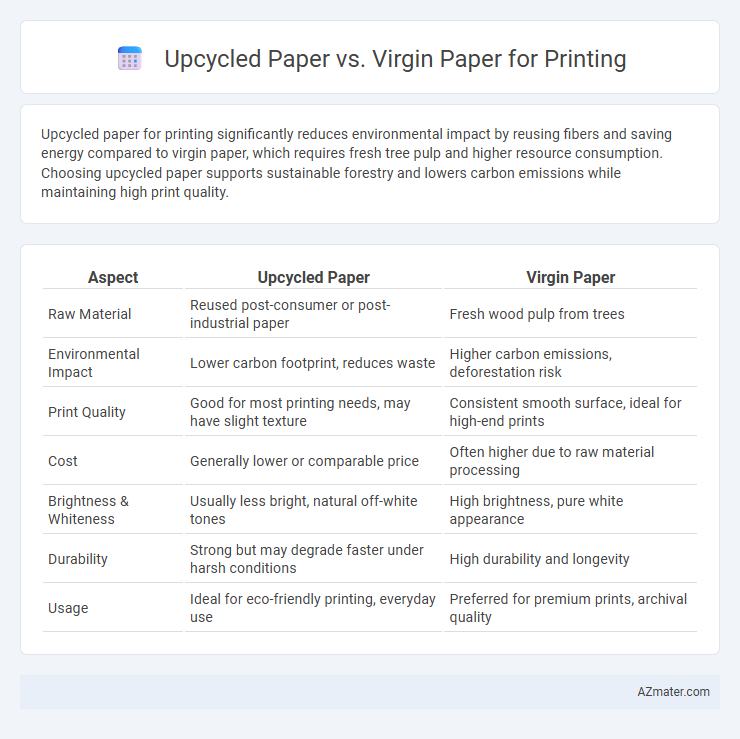Upcycled paper for printing significantly reduces environmental impact by reusing fibers and saving energy compared to virgin paper, which requires fresh tree pulp and higher resource consumption. Choosing upcycled paper supports sustainable forestry and lowers carbon emissions while maintaining high print quality.
Table of Comparison
| Aspect | Upcycled Paper | Virgin Paper |
|---|---|---|
| Raw Material | Reused post-consumer or post-industrial paper | Fresh wood pulp from trees |
| Environmental Impact | Lower carbon footprint, reduces waste | Higher carbon emissions, deforestation risk |
| Print Quality | Good for most printing needs, may have slight texture | Consistent smooth surface, ideal for high-end prints |
| Cost | Generally lower or comparable price | Often higher due to raw material processing |
| Brightness & Whiteness | Usually less bright, natural off-white tones | High brightness, pure white appearance |
| Durability | Strong but may degrade faster under harsh conditions | High durability and longevity |
| Usage | Ideal for eco-friendly printing, everyday use | Preferred for premium prints, archival quality |
Introduction to Upcycled Paper and Virgin Paper
Upcycled paper is produced by transforming waste paper materials into new sheets, reducing the demand for raw resources and minimizing environmental impact. Virgin paper is made directly from fresh wood pulp, offering higher strength and smoother finishes ideal for premium printing needs. Choosing between upcycled and virgin paper influences sustainability, print quality, and overall production costs in various printing applications.
Environmental Impact of Upcycled vs Virgin Paper
Upcycled paper significantly reduces environmental impact by lowering deforestation rates and conserving water compared to virgin paper, which relies on freshly harvested wood pulp. The production of upcycled paper emits fewer greenhouse gases and requires less energy, contributing to a smaller carbon footprint. Choosing upcycled paper for printing supports sustainable resource management and reduces landfill waste, making it an eco-friendly alternative to traditional virgin paper.
Resource Consumption in Paper Production
Upcycled paper production significantly reduces resource consumption by reusing existing fiber materials, cutting down on water, energy, and raw wood demand compared to virgin paper. Virgin paper manufacturing relies heavily on logging, intensive water use, and energy-intensive processes, contributing to higher environmental impact. Choosing upcycled paper supports sustainable forestry by minimizing deforestation and reducing greenhouse gas emissions associated with primary fiber extraction.
Quality and Printability Comparison
Upcycled paper for printing offers a sustainable alternative with increased fiber bonding that often results in a slightly rougher texture and lower brightness compared to virgin paper, which typically provides superior whiteness and smoother surfaces for high-resolution prints. Virgin paper, derived directly from fresh wood pulp, ensures consistent fiber quality, offering optimal ink absorption and sharper image clarity essential for professional printing tasks. However, advancements in upcycled paper processing have improved its printability, making it a viable option for everyday printing needs where environmental impact is a priority.
Cost Analysis: Upcycled vs Virgin Paper
Upcycled paper typically costs 10-30% less than virgin paper due to reduced raw material expenses and lower energy consumption in manufacturing. Virgin paper, made from fresh wood pulp, incurs higher production costs related to logging, processing, and environmental compliance. Businesses aiming to reduce printing expenses can achieve significant savings by choosing upcycled paper without compromising print quality.
Applications and Suitability for Printing
Upcycled paper offers an eco-friendly alternative for printing applications requiring moderate quality, such as flyers, brochures, and notebooks, due to its slightly rougher texture and lower brightness compared to virgin paper. Virgin paper, made from fresh wood pulp, is preferred for high-quality printing needs like professional brochures, books, and marketing materials because of its smooth surface, higher opacity, and consistent color reproduction. Both papers suit different printing technologies, but virgin paper aligns better with high-resolution inkjet and laser printers, while upcycled paper performs well with digital and offset printing where sustainability is prioritized.
Energy and Water Usage: A Comparative Overview
Upcycled paper significantly reduces energy consumption, using approximately 28% less energy compared to virgin paper production, which requires intensive processing of raw wood fibers. Water usage in upcycled paper manufacturing is also markedly lower, often cutting water consumption by up to 50%, as it repurposes existing paper fibers rather than relying on fresh pulp from trees. These efficiencies contribute to a smaller environmental footprint, making upcycled paper a more sustainable choice for printing purposes.
Waste Generation and Circular Economy Benefits
Upcycled paper significantly reduces waste generation by repurposing post-consumer materials, thereby lowering landfill contributions compared to virgin paper, which relies on fresh tree fibers and generates higher deforestation and industrial waste. The circular economy benefits of upcycled paper include minimizing raw material extraction, conserving energy, and promoting sustainable resource cycles through repeated reuse and recycling. In contrast, virgin paper production often disrupts circular flows due to its linear reliance on new inputs, emphasizing the environmental advantage of upcycled paper in sustainable printing practices.
Sustainability Certifications and Industry Standards
Upcycled paper often carries certifications such as FSC Recycled and Green Seal, highlighting its reduced environmental impact through the reuse of post-consumer materials and lower energy consumption. Virgin paper is typically certified by FSC and PEFC, ensuring the sustainable management of forests but involves higher resource use compared to upcycled alternatives. Industry standards emphasize ISO 14001 compliance for environmental management, with upcycled paper generally scoring better due to its circular economy benefits and reduced carbon footprint for printing applications.
Future Trends in Eco-Friendly Printing Solutions
Upcycled paper and virgin paper represent key materials in sustainable printing, with upcycled paper gaining traction due to its reduced environmental impact and lower resource consumption. Future trends in eco-friendly printing solutions emphasize increased use of recycled fibers, advancements in biodegradable inks, and integration of closed-loop recycling systems to minimize waste. Innovations in digital printing technologies also support the shift towards greener practices by reducing material waste and energy usage.

Infographic: Upcycled paper vs Virgin paper for Printing
 azmater.com
azmater.com